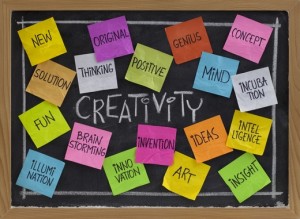 Creativity in Education and at Home: How to cultivate creativity in children
Creativity in Education and at Home: How to cultivate creativity in children
Most parents would be proud if their child was the one who discovered the cure for cancer. In all likelihood the cure will come from a gifted individual who is also a creative thinker, someone who has the ability to look at old information in a new way. Unfortunately, creative thinking is not a priority in many homes and schools. However, creativity is very important to a child’s development.
As an awkward nine-year-old, I remember standing beside the worktable in my father’s art studio. I watched his muscles flexing in his forearms as he applied pressure to the glasscutter; long fingers masterfully wrapping each individual piece of colored glass with copper foil; the smell of solder as he melted and smoothed it between the edges.
Ever so slowly, it came together like a puzzle in which the pieces seem to fall naturally into place. I questioned him, “How could I ever create something of such lasting beauty when I’m not artistic like you?” His reply, “Everyone has a seed of creativity somewhere inside them.”
As parents and educators we are detectives of sorts, searching for those seeds of potential in children. Many of our children are at risk of falling between the cracks, drifting in mediocrity rather than reaching their full potential as tomorrow’s great thinkers.
Modern science has yet to provide us with a complete blueprint to effectively educate our children. The diverse background each child brings to the classroom requires teachers to tap their own resources of knowledge, experience and inventiveness, in order to create a unique educational environment which challenges every child.
Children do not need to be on the same task, at the same time or learning at the same rate as their older siblings did or even as other students in their class. Daily practice needs to look different from child to child because children learn differently. As teachers and parents we have to be willing to go above and beyond, if we expect children to do the same. When we are enthused, they are enthused. When we are motivated, they are motivated.
Creativity can contribute to solving almost any problem; it’s not why something can’t be done, it’show it can be done. It’s helping diminish the student’s anxiety about being different, allowing them to develop their creativity, identify their competencies and forge self-confidence without constant need for outside validation. Children’s learning comes through discovery, making personal connections, integrating new information and creative application.
When a child brings work to you and asks, “Do you like it?” A good reply is, “A more important question is, do you like it? Why or why not?” Questions are great levers to thought and we want this next generation to think!
It’s important to give children specific feedback, rather than general feedback on their work. For example, if a child shows an adult a picture they drew of a landscape, many adults would respond with a general comment, “I love your drawing, it’s so pretty!”
Comments which are vague don’t help build self-esteem. It is better to say something specific such as, “I really like the way you added purple to the leaves of your trees, most people would have just used green, and it almost looks like shadows are being cast from the clouds.” This helps the child know exactly what they did well and even young children will recognize the sincerity in this comment. In turn, this will help build confidence.
Like adults, students respond to choice and independence and this builds confidence. While we need assessments to know whether our methods are working, it is imperative that we remain creative in our teaching.
Lying on the worktable in my father’s art studio, the stained glass windows appear cloudy and dark, hiding the beauty and harmony of his skill. Yet, when installed, my father’s creations spring to life with the radiance of sunlight–his artistry infused with magic.
While our work–as an art–is never truly finished, let’s honor the challenge to use every creative effort to inspire each child to fulfill their potential. Even if this next generation doesn’t find the cure for cancer, given the opportunity, they will find new ways to look at this world.
See Also: Test for Creativity




[…] so many people concerned about our educational system today, it is time to get more citizens into the classroom. Acting as a guest presenter in your […]
[…] Forum held in Oklahoma, he makes some strong points I’ve been attempting to make for years (my philosophy here). He states it well in this […]
You’re so right that creativity can contribute to solving almost any problem. It’s not just relative to art.
Thanks,
Gwynn Torres
The Creativity Institute